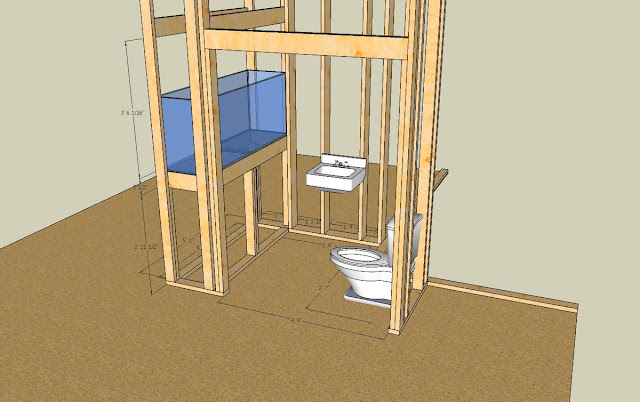 |
| Rick working on the drain/vent lines |
The rough plumbing has started. After months of
obsessing research, I actually have to decide now about showers, shower heads, faucets, etc.
I'll spare you.
But the hot water heater heater is more relevant. In a tight, super-insulated house, a large fraction of the total energy usage goes toward hot water, so deciding how you want to heat your water is an important consideration. The choices boil down to: electric vs. natural gas and tankless vs. tank-type. Oh, and possibly solar hot water as well. Greenbuildingadvisor.com has a great rundown on all the
options for water heating.
Tankless at first seems very appealing. They're small; they have the promise of never running out of hot water and they don't have any energy losses while not in use. The disadvantages: they're expensive to install, they're complicated and if they break, more expensive to repair or replace, they add a bit of extra time before hot water appears at the faucet, and they have to be sized for the worst case hot water draw.
Based on all that, I've decided to go with a tank-type.
So gas or electric? Given that I have a natural gas line running to the house, there's a strong argument that I should go with gas. From a carbon footprint point-of-view, it's better to use gas, since a gas-fired power plant will
use about 3 times as much gas to generate the electricity to heat a given amount of water as a gas hot water heater would use to heat the water directly. It's actually more complicated than that since some electricity is generated by solar/wind/hydro (better) and some by coal (worse).

But there's a new generation of electric hot water heaters that doesn't heat the water directly but instead uses a heat-pump. These electric hot water heaters are about 2.5 times more efficient than the old style. So 3 divided by 2.5 is 1.2. In other words, an electric heat-pump hot water heater will burn about 20% more natural gas (at the power plant) than would be needed to heat the water directly by burning gas (in a gas hot water heater).
You can probably already see where this is going - I chose an electric heat-pump hot water heater for several reasons.
- When you have solar panels on your roof, the monthly savings are greater if you use the electricity they generate rather than pumping that electricity back into the grid.
- The cheaper installation costs.
- I won't need to have a vent running through the roof to vent the combustion products of a gas unit.
- This would have been the only natural gas appliance in the house and I like the idea of one fewer bill and one fewer company to deal with.
- Because I have a full basement and the basement is unconditioned (outside the insulated building envelope) I won't be affected by the somewhat noisy heat-pump.
- When the heat pump is running, it removes humidity from the air. So I'll get a slightly dryer basement.
The particular model I chose is the
GE Geospring. It's $1000 direct from GE and there's $300 federal rebate, so it'll wind up costing me about $700 plus shipping and tax and getting a 240v outlet installed for it.
So what about solar hot water? For me, it just adds way too much complexity - a whole additional mechanical system that has to be installed, maintained and repaired. Plus, with the increasing efficiency of photovoltaic panels, there a
growing school of thought that it actually saves money to use the roof space for additional photovoltaic panels rather than solar thermal panels.















































